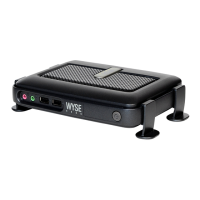Examples of Common Printing Configurations 83
Using Your Thin Client as a Print Server (LPD)
A ThinOS thin client can be configured as a basic network print server, to share local
printers with other thin clients.
Using the Printer Setup Dialog Box for Configuring LPD Services
From the Classic Desktop mode only, a thin client can be configured to provide LPD
(Line Printer Daemon) services (making the thin client a printer server on the network).
Set-up the thin client that is to provide LPD print services as follows:
1. Open the Network Setup dialog box (Desktop Menu > System Setup > Network
Setup) and enter a static IP address for the thin client.
2. Open the Printer Setup dialog box (Desktop Menu > System Setup > Printer) and
select any of the listed ports.
3. Select LPT.
4. Name the printer in the Printer Name box.
5. Enter the Printer Identification type or model of the printer in the exact text of the
Windows printer driver name—including capitalizations and spaces. In our example
case, enter HP LaserJet 4000 Series PCL.
6. You can leave Printer Class blank.
7. Select Enable the Printer Device.
8. Select Enable LPD service for the printer.
9. Set up the application server (see “Setting Up Windows 2003/2008 Servers” ).
Setting Up Windows 2003/2008 Servers
1. Navigate to Control Panel > Administrative Tools > Services and ensure the
Microsoft TCP/IP Printing service is installed. If it is not, install it using the Microsoft
installation instructions.
2. Add the thin client as the LPD printer by completing the following:
a. Navigate to Control Panel > Printers > Add Printers > Local Printer > Create a
new port and select LPR PORT.
TIP: If you do not see LPR Port, ensure that the Microsoft TCP/IP Printing service
is installed correctly.
b. Type the thin client IP address or DNS name in the Name or address of host
providing LPD box.

